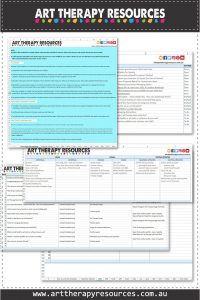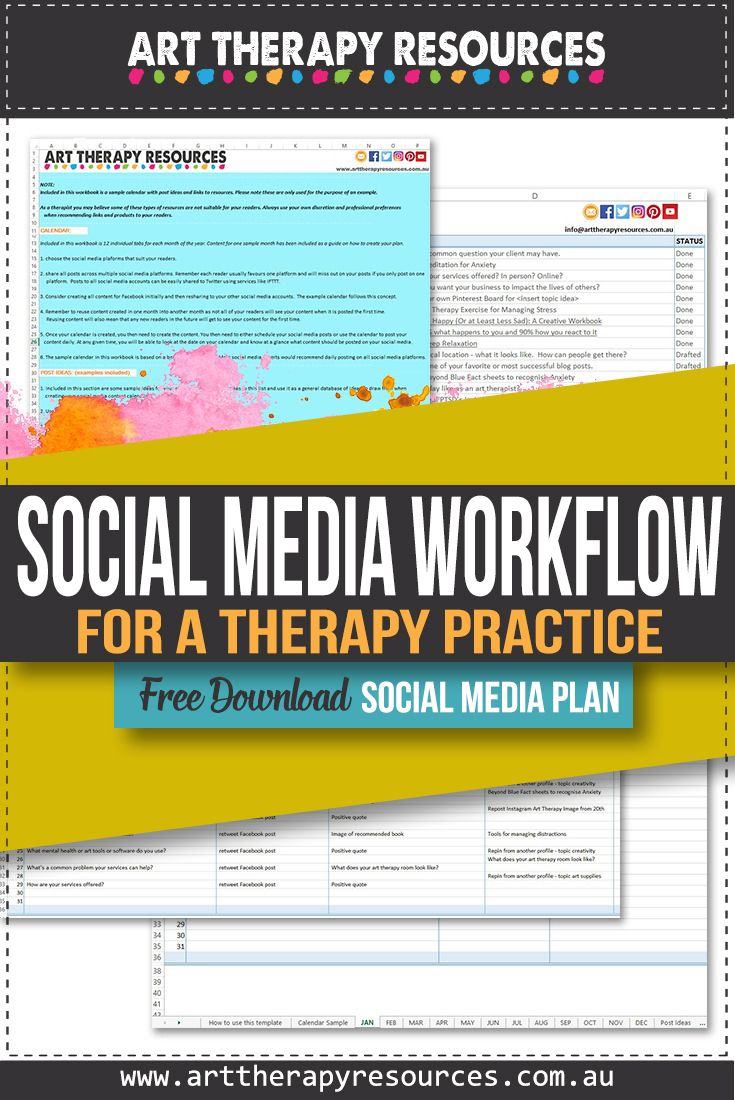THIS POST INCLUDES:
1. What is a social media workflow
2. Create a social media workflow
3. Automating your social media
4. Free Download Annual Social Media Plan Template
WHAT IS A SOCIAL MEDIA WORKFLOW
Having a social media presence seems to be an expectation of most businesses now. Even if you don’t use your social media platforms to engage directly with clients, most businesses use social media to simply establish some additional authenticity about the existence of their business. Generally, a social media presence will add to the legitimacy of your business as it represents a public face for your private practice.
Having a suite of social media accounts is the first step, however, you also need to regularly add content as a way of communicating to your readers. Regular content also indicates to viewers that your business is active and responsive to their readers.
It requires some effort to ensure your social media accounts are regularly updated for new content. Given social media networking isn’t a core part of your business, this is a task that you will want to automate as much as possible so that you can get back to the task of art therapy.
Systems are usually the best way to eliminate or reduce onerous administrative tasks. This can also apply to how you manage your social media content.
A workflow helps you establish the steps in your social media marketing efforts. An effective workflow is usually formally constructed and most importantly it is repeatable so that all of the steps in the workflow are started and completed as efficiently and quickly as possible.
For social media a typical workflow will include the following processes:
As you can see there are many parts to managing social media. If you are a sole business owner with a limited budget, you may need to complete all of the parts of your social media content marketing. To do this it’s essential to have a simplified workflow put in place to help you successfully plan, create, and distribute your social media content.
As your private practice grows, your ability to invest time in social media marketing will reduce while your need to use it will increase. Creating a workflow in the beginning stages of your social media use will help establish good time management practices for your business in the future to help you focus on growing your private practice.
CREATE A SOCIAL MEDIA WORKFLOW
IDENTIFY SOCIAL MEDIA ACCOUNTS
Before you create your social media workflow, it’s good to have an idea of the best social media platforms you should use as an art therapist. This may require that you experiment with a few different social media platforms to see where you gain most of your traffic and engagement from.
As art therapy uses images, you may find that Instagram and Pinterest are your most favourable platforms. This doesn’t mean that you should ignore other platforms such as Facebook or Twitter. Instead, it may mean that you use Instagram and Pinterest more organically and automate postings from Instagram and Pinterest to Facebook and Twitter.
It is difficult to dedicate a lot of time to manage multiple social media accounts, so the best approach is to focus on 1 or 2 and then repost content from those platforms to additional platforms that aren’t as active for your readers. This provides you with the benefit of additional exposure across multiple platforms but also ensures you are remaining focused on your most active social media channels.
DEFINE THE MESSAGE FOR EACH SOCIAL MEDIA ACCOUNT
Each social media platform has its own unique posting style. Facebook is good for sharing multiple types of media (audio, video, text, images) as well as long form written content. Twitter is good for sharing micro-content that grabs attention based on limited content. Pinterest is great for sharing images, and Instagram is great for sharing images along with the context of those images including stories and instructional videos. YouTube also provides a longer format for sharing similar educational content through video.
Each platform provides you with the opportunity to create content using specific mediums across various timeframes. Each platform has an appeal to its unique audience whether that be for those who like to consume long form content or for those who simply like to peruse short form content.
As you decide on the social media platforms that you want to use with your private practice, it is good to define the type of content that you want to share on each platform. For example, you may want to share worksheets on Pinterest, or show art making processes on Instagram, or publish long form written content about anxiety on Facebook.
If you use inappropriate content on different platforms you will disadvantage your audience as well as the effectiveness of your message. If you start publishing long form written content on Instagram, you may not get as much engagement as you would have by publishing a quick 30 second video on creating a mandala.
MAKE CONTENT CREATION TASKS EASIER
The most important outcome from developing a workflow is to make work easier that requires the least amount of input from you. To help this happen, you can use the following task strategies:
- BATCHING – creating a significant amount of similar work in one work session. For example, creating a month’s worth of posts in one work session instead of creating a new one each day. By batching content you are containing the workload into one single session where you can maintain focus on the type of work that you are undertaking
- REPEAT, REUSE, RECYCLE – in social media specifically, it’s helpful to repeat, reuse and recycle the same or similar content. Social media implements algorithms that restrict and control the content that your reader can see. This means that reusing and repeating content will have more chance of reaching your readers. Reusing content also means you can present similar information in slightly different variations which will help reinforce helpful information to your readers. Reusing content also extends to sharing content from other sources that is relevant to your audience. Sharing content from multiple sources is one of the tenets of social media.
DEFINE YOUR POSTING SCHEDULE
Most social media platforms have their suggestions for the frequency and timing of making social media posts. This may be something you have to experiment with to get an accurate picture of how your audience engages with your social media content.
Using an automated scheduler will make this process easier as you can easily choose times, days, and the number of times to repeat content.
Below is a snapshot of suggested social media posting timeframes. The information is taking from our Admin Package which you can find in the store here.
You can purchase the Admin Package in 3 formats including Scrivener, Evernote, and Microsoft Word
POSTING FREQUENCY
Advice on posting frequency changes regularly due to social media platforms adjusting their algorithms for engagement regularly. These are general guidelines to follow, however, you should always work within the limits of your business and available scheduling.

CREATING CONTENT
Check out our previous blog post to learn more about creating an annual social media plan in 60 minutes: How to Create an Annual Social Media Plan in 60 mins
To create your content more efficiently, you should consider the following steps:
- Establish a content calendar for the year https://arttherapyresources.com.au/annual-social-media-plan/
- Input specific holidays
- Input specific promotional periods
- Define the amount of content that you want to create each month and repeat that process for every month in the year
- Organise your content resources – this includes written content, images, audio, video, downloads etc. Create a list of sources that you can reuse content from or use to source your media resources from for creating your content such as images, audio etc.
- Create content – set up a work schedule of time to dedicate to creating content. Use the task strategies of batching, repeat, reuse, recycle.
- Share content – post and share the content that you create yourself and curate from external sources
For each content piece that you create you should implement the same steps:
- Research topic idea
- Outline topic idea
- Create content
- Edit content
- Schedule content posting
Using the principle of batching, it is more beneficial to conduct each of these steps in a bulk process of working as opposed to doing the same steps for each piece of content. For example, if you are creating your annual social media plan, create all of your topic ideas in one work session instead of conducting the individual 5 steps above.
If you batch your tasks, this means you will have created all of your topic ideas in one work session. The next time you sit down to create content you won’t have to spend time researching ideas and possibly getting sucked into a time vortex on the internet. By creating all of your topic ideas in one setting, it means each time you work on your content in the future, you will already be focused on the exact steps you need to undertake to create your content.
For each of the 5 steps listed above, you can create additional workflow steps to help you create content quicker. You can create templates for each of your social media platforms on how you like to write and share content.
A typical Facebook post might include:
- Title
- Written content
- Link to click
- Call to action request
- Image/video to use
A typical Twitter post might include:
- Written content
- Link to click/call to action
- Hashtags relevant to your topic
Once you establish a template for each platform you can then create content quickly by simply filling in the template fields. Templates can ensure that your content is created consistently in the format that you like for each platform.
Once your content is created, you may also like to use a checklist to follow to make sure your content is uploaded and scheduled correctly. This checklist can include important tasks such as:
- Check links work
- Check image is attached
- Check date for posting is selected
- Check SEO is included
Your checklist should include tasks to help you create consistent and complete content to match the social media platform that you are using. Social media marketing is a task that you most likely don’t undertake often, so using checklists will help you create your content the right way each time without having to remember all of the useful tips and tricks of social media posting.
Keep your checklist simple in the beginning and build upon your tasks as you become more skilled at using social media and learn more about how your audiences respond to your content.
AUTOMATING YOUR SOCIAL MEDIA
Manually posting your content is a significant investment of your time that you can reduce by automating your posting schedule. This can be done by using software that assists in automating posting. Using this software helps better manage your time, organise your content, and reduce the chance of making posting errors.
Using automatic posting also provides you with insight into the best times for posting and how your audience engages with your content.
Check out our previous blog post to learn more about scheduling your social media content using social media schedulers: Review of Free Social Media Schedulers
Further reading:
For more information on using social media for your private practice, check out our previous blog posts listed below:
FREE DOWNLOAD: Annual Social Media Template
SIGN UP below to download the FREE Annual Social Media Plan Template.

BUILD YOUR ART THERAPY REFERENCE MATERIALS:
Pin this image to your Pinterest board.

SHARE KNOWLEDGE & PASS IT ON:
If you’ve enjoyed this post, please share it on Facebook, Twitter, Pinterest. Thank you!
